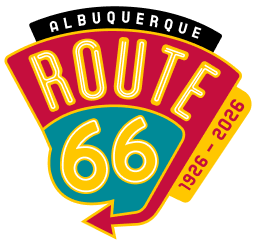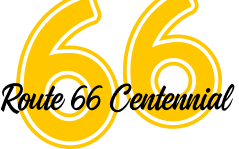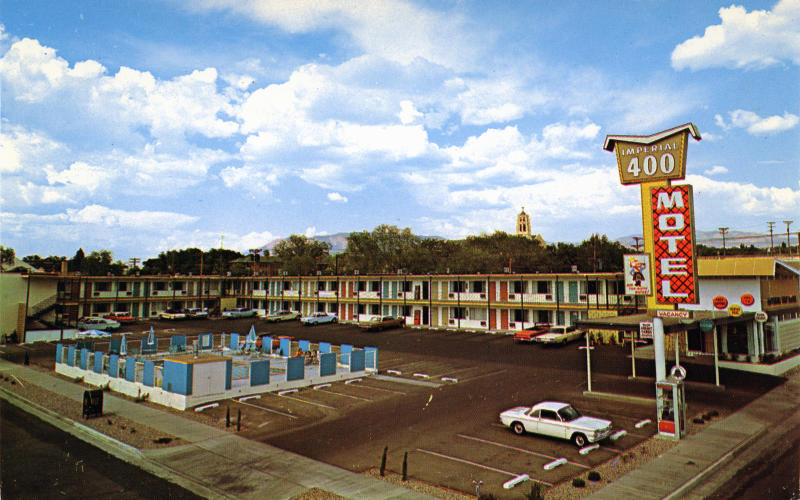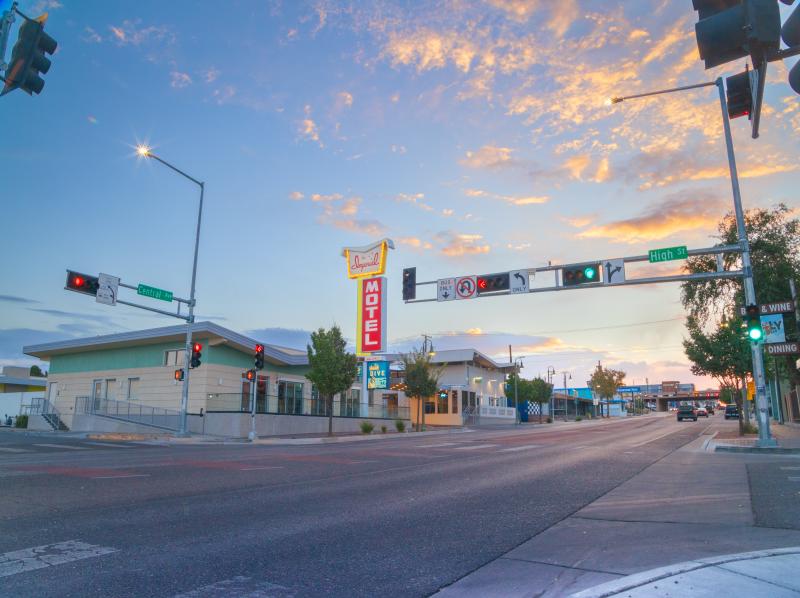
Visit Albuquerque prohibits users from downloading images from our website.
Please use our media library for downloadable images and usage rights.Explore Downtown Albuquerque
A Bustling Epicenter
Established in the 1880s after the railroad expanded near the village of Alburquerque, investors and boosters of the Southwest constructed a handful of buildings that would come to be known as “New Town.” In just a few decades, “New Town Albuquerque” (with the dropped ‘r’) would sprout up several skyscrapers, such as the First National Bank Building and the Sunshine Building, from 1st Street to 7th Street. The Fred Harvey hotel, the Alvarado, was graced by Silent movie stars and later housed WWII soldiers en route to California. The stretch of road that comprised Downtown was known as “Railroad Avenue” in its early years. In 1912, Railroad Avenue was renamed as “Central Avenue” with the optimism that this dirt road would be the main artery to the heart of Albuquerque: Downtown. Route 66 tourism played a major role in manifesting the prophecy of Central Avenue – all wonderful 18 asphalt miles of it.
Today, the Downtown core experiences a renaissance fueled by the Route 66 Centennial. The iconic KiMo Theatre (c. 1927) stands proud at the corner of 5th Street and Central Avenue as the only Pueblo Deco picture palace in the nation, an eclectic embodiment of the diverse Native cultures that surround the city. Across the street is 505 Central Food Hall, an indoor food hall that inhabits the 1938 Sears & Roebuck building, distinguished by its streamlined facade. Walk off your lunch with a quick trip to 516 Arts, a non-profit contemporary art gallery that shows off New Mexico’s cutting-edge creativity. For the Americana enthusiast, Lindy’s Diner is the oldest continually operating diner along New Mexico’s Route 66, in operation since 1929. Cap off the night at Ex Novo Brewing Co., one of the newest additions to the Downtown scene as of 2024. Ex Novo transformed an original 1930 Art Deco gas and service station into a multi-level taproom, cocktail bar and lunchtime deli – with the menu courtesy of Chef Marc Quiñones.
So take a cue from the lowriders: The abundant sights of the Downtown scene are best experienced slowly, especially during the weekly Sunday night cruise in Downtown. Yield for roadrunners!
Explore more around Downtown
West Downtown/Raynolds Addition
On the west end of Downtown Albuquerque is the Raynolds Addition neighborhood. If you’ve seen AMC’s “Breaking Bad,” you’ll recognize some iconic locations in this neighborhood: Robinson Park, Java Joe’s and The Dog-House Drive-In. Closer to the neighborhood surrounding the Albuquerque Country Club is Jesse Pinkman’s house. West Downtown is a vivid, walkable area with public art, murals and parks to enjoy while you stretch your legs. From spring to fall, the Downtown Growers Market convenes at Robinson Park from 8 a.m. to noon on Saturdays – it’s the perfect place to shop like a local in Albuquerque’s 310 days of sunshine.
It can be difficult to eat clean on the road. Look no further than salad bar Vinaigrette in West Downtown to take a break from all that delicious diner food. Vinaigrette is housed in the former World Court and Service Station, constructed in the 1940s.
World Court and Gas Station, ca. 1950, gelatin silver print on cardstock. Albuquerque Museum, gift of Nancy Tucker. PA2021.065.030.
East Downtown
Franz Huning, a German immigrant, was among the first civic leaders to envision an expanded Albuquerque. Huning and his family lived near Old Town Albuquerque and had neighborly relationships with the locals. Huning collaborated with land surveyor brothers, Robert and Walter Marmon, to develop the land east of the railroad. When you drive through EDo, you will pass by the Huning and Marmon family legacy in a neighborhood known as Huning Highlands: Arno Street, named after Franz Huning’s son, and Edith Boulevard and Walter Street, named after the Marmon children.
You might notice that EDo’s architectural character is distinct from most of New Mexico, resembling a small East Coast town with its Queen Anne pitched roofs and Dutch-style bungalows. This was the result of people from the East Coast getting off the train and settling in Albuquerque, bringing along materials and design philosophies from their homes. The Old Albuquerque High School, a 1914 Gothic Revival complex at the corner of Central and Broadway, is the pinnacle of EDo’s neighborhood character and now functions as a residential complex today.
That’s not to say EDo doesn’t have that classic-cool mid-century charm of Route 66. The Imperial Inn is a 1960s chain motel-turned-boutique hotel, food hall and lounge. The Imperial’s food and poolside amenities are open to both motel guests and visitors alike. The Imperial’s check-in office is even equipped with a coffee bar, Mojo Rising.
The Imperial 400 Motel, c. 1970. Albuquerque Museum, gift of Nancy Tucker. PA2014.007.269
The Imperial Inn, today. Photograph by Dominic Valdez.
EDo’s restaurant scene is known for its upscale dining, such as Farina Pizzeria & Wine Bar and The Artichoke Cafe. However, if you are looking for something a little more casual on your road trip, the Grove and Range Cafe Downtown have the vibes you seek. Range Cafe is in the historic Mauldin & Carothers Service Station, an authentic 1939 Route 66 pit stop! After a meal, get your steps in at Heck Yeah! Vintage, EDo’s clothing source for vintage-lovers and Route 66 romantics.





